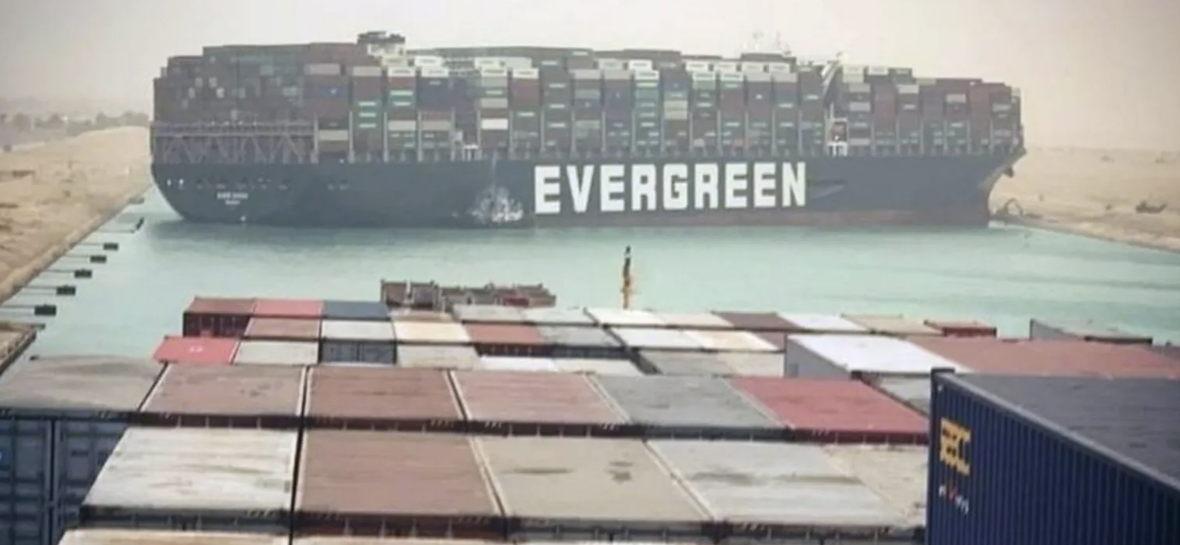
Posted December 22, 2023
By Byron King
Red Sea, Dead Sea: Global Chessboard Puts International Trade in Check
By now, you’ve already heard about what’s happening in the Red Sea, where Houthi forces in Yemen have targeted merchant ships.
This is an evolving story, and it will affect the global economy — all the way down to your wallet.
Meanwhile, there’s a profoundly strategic angle here. Truly, it involves the fate of nations, and all of this mess will blow back on us. Pay now or pay later; we’re going to pay.
Strap in…
Set the Stage With Geography
The quick overview is that a group called Houthis controls part of Yemen, a nation strategically located at the narrow strait at the south end of the Red Sea. Note that Houthis are not the “official” government of Yemen; they just run a big whack of the place.
These Houthi actors have begun to attack and seize merchant ships near their Red Sea shores, as well as fire missiles at other vessels, including U.S. Navy ships. Here’s a map to help illustrate the geography:

Houthis control southern access to the Red Sea. Map via Washington Post.
U.S. warships carry systems to deal with inbound missiles, although beware the shot that leaks through. But obviously, boardings, seizures, and flying missiles pose great danger to commercial vessels, crews, and cargoes. Thus, several key global shipping firms, ranging from Maersk to BP oil company, have announced that their ships will no longer sail through the Red Sea.
This map generally illustrates the problem of geography that it all entails:

If you can’t sail the Red Sea route, the other way is 40% longer.
Sailing around Africa adds time and expense to every voyage, whatever the cargo. And this immediately disrupts global trade.
For example, recall the cargo ship that ran aground in the Suez Canal in March 2021. Back then, M/V (merchant vessel) Ever Given, owned by a Taiwanese company called Evergreen Shipping, hit a sand bar in the canal and became wedged.

Whoops! A 200,000-tonne impediment. Courtesy BBC.
This incident blocked the canal for over six days. And it disrupted the voyages of no less than 450 other vessels in both directions. Direct damages were in the billions of dollars in excess vessel day rates (i.e., charges to charter a ship), plus “demurrage,” the cost payable to a ship owner for delays in loading or unloading.
Meanwhile, the government of Egypt demanded well over a billion dollars in damages from the ship owners for loss of tolls and use of the Suez Canal and costs associated with refloating the vessel.
Overall, the logistical effects of this single, accidental event were felt on store shelves in the U.S. in terms of goods delayed in transit due to ships rerouting around Africa or other sorts of delays and expenses. I won’t get deep into further details; just emphasize how blocking navigation through the Suez Canal becomes immediately and globally expensive.
Reuters News reads, “About 15% of world shipping traffic, including roughly 30% of global container trade, passes through the Suez Canal. Routing ships around Africa would increase a round-trip journey by about two and a half weeks, cutting shipping capacity and pushing up costs.”
So, just with this one example, you can see how Houthis blocking the southern entrance of the Red Sea makes a mess, right?
What’s Really Happening Here?
Now comes the next question: Why would the Houthis block ship traffic to and from Suez? What’s really going on?
First, this is not just another version of Houthis' high-seas piracy. Okay, sure; they may want payoffs and ransoms to change their behavior because everybody loves to make a few bucks. But what’s happening here goes far beyond just money.
The cover story for what Houthis are doing is that they’re in solidarity with the Palestinians of Gaza, currently being invaded and bombed to rubble by Israel, post-October seven military actions by Hamas in that region.
In fact, Houthi leaders have declared war on Israel. And they announced that they’ll attack ships headed to or from that nation. Plus, if any foreign navies try to halt the mighty Houthis, they have vowed to turn the Red Sea into a “graveyard.” Sure… it’s a typical bombast, but it’s also never good to have high-explosive drones and cruise missiles flying around.
Meanwhile, Houthis have attacked vessels that have nothing to do with Israel; the cargoes originated and are destined to land elsewhere. In any event, Houthis cannot truly blockade Israel just from the south because that country also has a coastline along the Mediterranean (see map above).
In other words, Houthis cannot do all that much harm to Israel in terms of strangling trade. But then comes the question: as everything unfolds, who IS being harmed the most? Answer: Egypt.
That is, when vessels reroute around Africa, Egypt immediately feels the loss. Egypt loses out on tolls, fees, and other business associated with running the Suez Canal. Tolls speak for themselves: about $7 billion annually to Egypt, over $19 million daily.
Fees include payments to canal pilots, the expert navigators required by the government on every vessel in the canal whose services are not being used now. Add innumerable other business opportunities lost at facilities along the canal. These range from selling fuel, fresh water, and food to voyage repairs and removing trash from transiting ships.
A lowball number for economic loss to Egypt’s economy is over $25 million per day, likely more when all the secondary and tertiary impacts add up. This matter is hitting Egypt right in the state treasury.
Who Is Behind This Global Chessboard?
The entire chain of events is convoluted. Houthis are not the legal government of Yemen, but they control territory and claim technically to be at war with Israel. While Egypt, not Israel, is taking the big financial hit. Third-party nations are also suffering because their shipping must take the long route around Africa, costing time and money.
The U.S. and other Western nations are now organizing a multi-nation naval mission to defend Red Sea shipping called “Operation Prosperity Guardian.” (Honestly, I have NO idea who thinks up these silly names.)
With this in mind, consider a global chessboard. And focus on who supplies the bulk of funds and weapons to the Houthis. Hint: it’s Iran.
That is, Iran has long sponsored the Houthis in Yemen and has certainly supplied aircraft, drones, and missiles that Houthis use to attack Red Sea shipping. In this sense, an attack on global shipping by Houthis is an attack by Iran.
In terms of second-order effects, closing the Red Sea to shipping is also a financial attack on Egypt, again by Iran.
While we’re at it, think back to the original Hamas attack on Israel on October 7. Who is the key sponsor of Hamas? Who armed and trained the Hamas attackers? Yes, Iran.
To use a chess analogy, one pawn of Iran has already moved against Israel, namely Hamas. And now, another Iranian pawn – the Houthis – move to block not just Israel but also to harm Egypt and disrupt global trade.
Just these two moves alone – by pawns, no less! – have created a complex geographical and strategic quandary.
Israel is bogged down in Gaza, fighting Hamas and burning up both its army and credibility on the world stage with Stalingrad-like urban combat. One might say that the Israelis are precisely where the Iranians want them.
Meanwhile, Egypt is losing serious Suez Canal revenues. Although Egypt has a powerful military, the country is in no position to fly or sail down the Red Sea and make war on the Houthis. At home, the Egyptian economy will suffer. And considering how Egypt has long been friendly towards the West, this is likely a situation the Iranians are pleased with.
Elsewhere in the region, Saudi Arabia shares a long southern border with Yemen. But it’s unlikely that the Saudis will move against the Houthis because Saudi already fought an expensive and unsuccessful war in those parts just a few years ago. Saudi Arabia is amid a rapprochement with Iran after many decades of tension.
All this, and now the U.S. and other Western powers are preparing to move militarily and defend against the Houthis. There’s no telling what the exact response will be, although the collective military acumen of the Biden Administration is legendary and speaks for itself; hey, look at how Afghanistan ended or how Ukraine began.
If this is a game of chess, Iran just put the U.S. and West in “check.” Undoing the problem will require significant, decisive moves.
Looking ahead, and whatever unfolds, the application of serious combat power against Houthis will require significant ships and aircraft, if not land forces. Plus, combat power requires extensive fuel and other supplies, along with transcontinental-scale movement and staging.
But wait a second! All those U.S. and other Western military forces and logistic capabilities are badly drawn down after several years of Asia-Ukraine-Middle East tensions.
Hmm… I suspect that people are smiling in Tehran.
Where Does It Go from Here?
As I noted at the beginning, this situation is evolving. And there are many possibilities.
One thing is sure: global trade has just hit a major friction point. Hundreds and even thousands of ships are about to detour around Africa. This will slow commerce and increase the costs of everything that moves by ship, including oil and refined products.
Along the way, there’s more pressure on Israel to moderate its actions in Gaza, bring its military operations to an end, and deal with the Palestinians. For obvious reasons, expect pressure from Israel’s neighbor Egypt and more pressure from the West just due to the disruption in the trade of oil and other goods.
Any significant U.S. and Western military response stresses an already strained body of personnel, equipment, and logistic channels. Any large-scale fighting opens the door to a dark room, namely another military operation in the Middle East with the possibility of drawing in Iran and others.
All in all, risks are rising, along with higher oil prices and rising prices for other commodities and goods. Downstream, watch it all fold into eventual inflation.
One defense for investors is sticking with Western energy companies with little exposure to Middle East oil imports. They can also go with gold and silver and Western companies that produce the metals.
That’s all for now. Thank you for subscribing and reading.

How Others’ Incompetence Costs You Big-Time
Posted January 17, 2024
By Byron King

Turning Empty Cubicles Into Houses
Posted January 15, 2024
By Zach Scheidt

"Boring AI": Overlooked Opportunity From CES 2024
Posted January 12, 2024
By Zach Scheidt

5 Must-See Predictions
Posted January 10, 2024
By James Altucher

Welcome to Earth, the Mining Planet
Posted January 08, 2024
By Byron King
